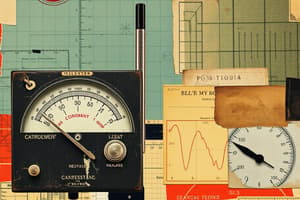Podcast
Questions and Answers
What is the measurement of 0.146?
What is the measurement of 0.146?
A1A2P3 Table 13-2
What is the definition of Biaxial/Multi Axial wire in which the tip conductor is exposed and less than 50% of the window length?
What is the definition of Biaxial/Multi Axial wire in which the tip conductor is exposed and less than 50% of the window length?
- Not acceptable for any installations
- Only acceptable for specific types of installations
- Only acceptable if inspected
- Acceptable for all Ch 13 Jack and Tip Installation (correct)
What is the target for wire, insulation, or solder that does not extend above the ring profile of biaxial wire?
What is the target for wire, insulation, or solder that does not extend above the ring profile of biaxial wire?
Target for all Ch 13 Ring Installation
Cable lacing begins and ends with which type of knot?
Cable lacing begins and ends with which type of knot?
What do we call wires in a wire bundle that twist and crossover underneath a restraining device?
What do we call wires in a wire bundle that twist and crossover underneath a restraining device?
Damage on restraining devices such as minor fraying, nicks, or wear of less than what percentage of the device thickness is acceptable?
Damage on restraining devices such as minor fraying, nicks, or wear of less than what percentage of the device thickness is acceptable?
When applying a tie wrap, if the cut end protrusion is greater than tie wrap thickness, what is the condition?
When applying a tie wrap, if the cut end protrusion is greater than tie wrap thickness, what is the condition?
If the spacing of the first restraint from a breakout is more than how many diameters of the breakout wire bundle, what is the condition?
If the spacing of the first restraint from a breakout is more than how many diameters of the breakout wire bundle, what is the condition?
What type of lacing is used when applying a single lock stitch on a branch after a double lock stitch?
What type of lacing is used when applying a single lock stitch on a branch after a double lock stitch?
What are spot ties or wraps placed over splices or ferrules contained in the wire bundle called?
What are spot ties or wraps placed over splices or ferrules contained in the wire bundle called?
What is the minimum acceptable length for a back braid lock stitch?
What is the minimum acceptable length for a back braid lock stitch?
Certified IPC Trainer CIT and Certified IPC Specialist certifications expire after how many years?
Certified IPC Trainer CIT and Certified IPC Specialist certifications expire after how many years?
Master IPC Trainers MIT are authorized to certify what?
Master IPC Trainers MIT are authorized to certify what?
A CIT is authorized to certify what?
A CIT is authorized to certify what?
If permitted by company policy, a CIT may grant an extension of up to how many days?
If permitted by company policy, a CIT may grant an extension of up to how many days?
What module is required as a prerequisite for IPC 620 CIS certification?
What module is required as a prerequisite for IPC 620 CIS certification?
CIS retesting may be taken only after a minimum of how many hours?
CIS retesting may be taken only after a minimum of how many hours?
What is the correct order of production status?
What is the correct order of production status?
The tolerance for magnification aid is?
The tolerance for magnification aid is?
The Manufacturer shall (_1_2_3) have a documented calibration system.
The Manufacturer shall (_1_2_3) have a documented calibration system.
What is a Process Indicator?
What is a Process Indicator?
Conditions that are not specified as defective or as a process indicator are considered?
Conditions that are not specified as defective or as a process indicator are considered?
Illumination at the surface of the workstation should be a minimum of?
Illumination at the surface of the workstation should be a minimum of?
A condition that is close to perfect defines what type of condition?
A condition that is close to perfect defines what type of condition?
When inspecting a 22 AWG wire, what is the inspection magnification range?
When inspecting a 22 AWG wire, what is the inspection magnification range?
What are the criteria defined in IPC-620 reflect three product classes?
What are the criteria defined in IPC-620 reflect three product classes?
If insulation thickness is reduced by more than 20%, the condition is?
If insulation thickness is reduced by more than 20%, the condition is?
Damaged wires that do not exceed the limits specified in Table 3-1 are considered?
Damaged wires that do not exceed the limits specified in Table 3-1 are considered?
Wire separation that exceeds one strand diameter but does not extend beyond the wire insulation outside diameter is?
Wire separation that exceeds one strand diameter but does not extend beyond the wire insulation outside diameter is?
The maximum number of damaged strands for Class 2 wires with 28 strands used at a potential of 6kV or greater is?
The maximum number of damaged strands for Class 2 wires with 28 strands used at a potential of 6kV or greater is?
Insulation that has been charred, melted into the wire strands, and has uneven or ragged pieces of insulation greater than 50% is what for all classes?
Insulation that has been charred, melted into the wire strands, and has uneven or ragged pieces of insulation greater than 50% is what for all classes?
Flashcards are hidden until you start studying
Study Notes
Certification Overview
- Certified IPC Trainer (CIT) and Certified IPC Specialist (CIS) certifications expire after 2 years.
- Master IPC Trainers (MIT) are authorized to certify CIT and CIS only.
- CITs have the authority to certify CIS.
Certification Extensions and Requirements
- CITs may grant an extension of certification for up to 90 days if permitted by company policy.
- Module 1 is a prerequisite for IPC 620 CIS certification.
- CIS retesting can occur only after a minimum of 24 hours.
Production Status and Tolerances
- The correct order of production status is: Design, PCB Fabrication, Assembly, Cleaning, and Coating.
- Tolerance for magnification aid is ±15.
- Manufacturers must have a documented calibration system (N1D2D3).
Process Indicators and Conditions
- A process indicator identifies a characteristic that should be monitored but does not affect the form, fit, or function of a product.
- Conditions not specified as defective or as process indicators are considered acceptable.
Workstation Illumination
- Illumination at the workstation's surface should be a minimum of 1000 lumens/m² or 93 foot-candles.
Inspection and Defects
- The inspection magnification range for 22 AWG wires is 1.5X to 3X.
- The IPC-620 standards reflect three product classes:
- Class 1: General Electronics
- Class 2: Dedicated Service Electronics
- Class 3: High Performance/Harsh Environment Electronics.
Insulation and Wire Conditions
- Reducing insulation thickness by more than 20% results in a defect for all classes.
- Damaged wires that meet specified limits are considered process indicators for classes 2 and 3.
- Wire separation exceeding one strand diameter but not beyond the insulation diameter can be acceptable.
Wire and Termination Standards
- The maximum number of damaged strands for Class 2 wires at 6kV or greater is zero.
- Insulation that is charred or melted greater than 50% of the diameter is deemed defective.
- For class 2 crimp terminations, a wire with 20 strands may have up to 3 scraped, nicked, or severed strands.
Twisting and Sleeving Requirements
- Wire twisting in cable bundles should have a length of lay between 8 to 16 times the bundle's other diameter.
- Insulation thickness gaps either less than or greater than specified values lead to different classification outcomes.
Solder Connections and Conditions
- A wire wrapped to a turret terminal with a minimum of 180 degrees is considered a target.
- Insulation displacement connections must not be reworked after making the connection.
Potting and Lacing Guidelines
- Potting materials should not block electrical mating surfaces and must adhere properly.
- Cable lacing should begin and end with a locking knot and follow proper spacing and securing methods.
Length and Orientation Specifications
- A 7-foot cable has a tolerance of +4 inches - 0 inches.
- Marker sleeve wraps must have a minimum of 1.25 times the necessary length for acceptance.
Additional Standards and Acceptability
- Nicks or cuts in insulation post-screen removal are defects.
- Soldering conditions should not interfere with assembly and involve specific tolerances for wire protrusion.
Studying That Suits You
Use AI to generate personalized quizzes and flashcards to suit your learning preferences.




